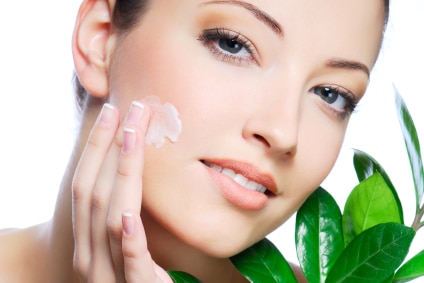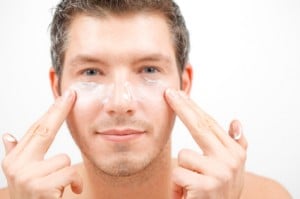 What You Put on Your Skin Goes into Your Body
What You Put on Your Skin Goes into Your Body
Everything you put on your skin gets absorbed into your body so be wise with what you put on your skin. An Ayuverdic principle is never put anything on your skin that you would not eat. You’re about to find out why. Skin care products are big business. Guess what? Many skin care products may be affecting your health adversely because of toxins in the products and in their packaging. Today we are going to tell you which skin care ingredients to avoid and why and in a future post which ingredients you should look for in your quest to look healthy and youthful.
According to the the Environmental Working Group 20% of beauty products contain chemicals linked to cancer and 80% have ingredients containing hazardous impurities.
Now for you women this discussion also applies
Inflammation: A Root of Aging
Inflammation is a major cause of aging – for your skin and body in general. Though you purchase skin products with a goal of looking younger and healthier many products contain ingredients that add to the inflammatory load the body is subjected to. Some ingredients accelerate the aging process by damaging DNA and others are hormone disruptors or mimickers. Collectively these toxic ingredients can actually cause or exacerbate the following dermatologic conditions:
- acne
- age spots
- eczema
- hair loss
- hyperpigmentation
- photo damage
- psoriasis
- rosacea
- skin tags
- wrinkling and loose skin
But there is more than just that. These ingredients can exacerbate or contribute to chronic diseases related to inflammation. We have discussed all the chronic health conditions caused by inflammation in Silent Inflammation and Chronic Disease.
There is one hormone related condition we should discuss that hits home for women that can be compounded by skin care products. Breast cancer. Many skin care products contain estrogen like ingredients overloading the body with too much estrogen activity and increasing the risk of breast cancer.
Estrogen must be balanced with adequate amounts of progesterone. As women go through menopause they lose progesterone faster and steeper than they do estrogen. So women already have an imbalance (known as estrogen dominance) between those two hormones as they go through the change. That is further compounded by estrogen activity found in some of their cosmetics. Progesterone is necessary to offset the proliferative or tissue growing effects of estrogen on breast tissue and the endometrial lining.
Skin care products and other sources of estrogen activity (plastics including cosmetic jars) may be a major reason why breast cancer rates have increased compared to prior generations not exposed to so many environmental toxins.
Skin Care Ingredients to Avoid
Here are the toxic ingredients you want to avoid and the reasons to avoid them in italics.
- triethanolamine/diethanolamine: mimic estrogen
- sodium laurel/laureth sulfate/sarcosinate: toxic to cell membranes and destroys collagen
- propylene glycol: petroleum derivative and inflammatory
- PEGS: carcinogenic, inflammatory, and toxic
- parabens: toxic and inflammatory and mimic estrogen
- ureas: convert to formaldehyde and inflammatory
- acrylates/methylarylate: toxic and inflammatory
- mineral oil: petroleum derivative, toxic and inflammatory
- tricoslan, alcohols, synthetic fragrances: mimic hormones, carcinogenic, inflammatory, and toxic.
- DMDM hydrantoin: it’s formaldehyde and carcinogenic and causes rashes
- petroleum: skin irritants and blocks pores
- retinyl palmitate: increases cancer risk and inflammatory
- oxybenzone: sex hormone disruptor
- ammonium and aluminum: toxic and inflammatory
- sodium bisulfite: allergen and inflammatory
 Many skin products also contain metals that should be avoided. These metals are banned as intended ingredients but are found in many skin care products as impurities. Though the concentrations of these metals in any one skin product meet safe levels as established by the federal government it is likely that you are using more than one skin care product a day. It’s the accumulation of all these metals/impurities in all the products that you use that matters. So you may still be receiving toxic loads of these metals that can cause skin problems and have systemic effects. Here are the metals to be on the lookout for.
Many skin products also contain metals that should be avoided. These metals are banned as intended ingredients but are found in many skin care products as impurities. Though the concentrations of these metals in any one skin product meet safe levels as established by the federal government it is likely that you are using more than one skin care product a day. It’s the accumulation of all these metals/impurities in all the products that you use that matters. So you may still be receiving toxic loads of these metals that can cause skin problems and have systemic effects. Here are the metals to be on the lookout for.
- antimony
- arsenic
- cadmium
- chromium
- cobalt
- lead
- mercury
- nickel
Toxic Ingredients Found in Peels
- Glycolic acid: strong irritant that generates free radicals, synthetic form of formaldehyde, breaks down epidermis
- Hydroquinone: weakens immune system, toxic to liver and kidneys, causes genetic mutations
- Trichloroacetic acid: strongly inflammatory/irritant, corrosive, affects pigmentation
- Salicylic acid: allergen, dries skin, can cause metabolic acidosis
Dangerous Packaging Ingredients
Not only can ingredients and impurities in skin care products be harmful so can the containers and packaging they come in. Packaging materials should be nontoxic to avoid penetrating chemicals like hormone disruptors from leaching into the actual product.
Packaging should be free of BPA, phthalates, and plasticizers. BPA can leach out from polycarbonate plastics and epoxy resins and into food, beverages, and skin care products.
BPA has harmful effects on the reproductive tracts in men and women and is linked to behavioral problems and increased risks of obesity and heart disease. In males it is associated with decreased sperm counts, libido, erectile dysfunction, and ejaculatory disorders. In women it is linked to irregular menstrual cycles, ovarian cysts, and early onset sexual maturity.
These recommendations on packaging go beyond skin care products and apply to all products you buy.
Looking beyond skin care products avoid plastic containers as much as possible especially those flimsy plastic bottled water bottles that can leach hormone disruptors and avoid consumption of liquids in aluminum cans. Aluminum is the most abundant neurotoxic metal and is linked to Alzheimer’s disease. Glass is still best. But plastic is everywhere including the hospital and doctor’s office and challenging to avoid completely. Lots of plastics used in medicine – IV tubing, IV bags, and syringes just to name a few.
*And for you women these recommnedations also apply to any product you put on down you know where. The vaginal mucosa is very good at absorbing anything put on it even better than the skin. If vaginal lubrication is a need consider natural lubricants like coconut oil.
In an upcoming post we will discuss what ingredients to look for in a healthy skin care product.
Much of the content for this article comes from a talk presented on December 13, 2015 at the American Academy of Anti-Aging Medicine’s 23rd World Congress by Julia Hunter, MD. Dr. Hunter is a Beverly Hills dermatologist.
